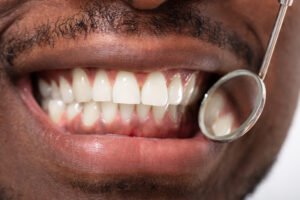How to Know If You Have Gum Disease?

Healthy oral hygiene goes far beyond just white and spotless teeth. While you’re awaiting qualification as the individual with the healthiest pearly whites, you often tend to neglect other equally important aspects of your oral health, namely your gums. Gum health is considered a vital pillar for both dental and holistic wellbeing as major predatory forces camp in and under your gums, ready to deplete the last of your oral hygiene and health.
In fact, gum disease, otherwise known as periodontal disease has long been known as the leading cause of tooth loss in adults around the world. Unfortunately, the dangers of gum disease aren’t centered only in your mouth. Over the years, studies have elucidated that gum disease is strongly linked to an increased risk of serious degenerative illness, like heart disease, stroke, and even diabetes.
So, how do you identify the earliest signs of gum disease before it gets worse? Below are a few signs you can look out for if you suspect a prolific gum disease in the rise!
HOW DOES ORAL HEALTH WORK?
Would you believe us if we told you that you’re constantly sitting on a landmine? Yes, your mouth is a ticking time bomb, sensitive to change and trauma. At all times, your mouth houses a complex labyrinth of microorganisms that live harmoniously until proper oral hygiene mechanisms are supplied to it. But, if you’ve declared a ‘cheat day’ against brushing or flossing or any of those cleansing methods, you’re at risk of a bacterial overrun.
Bacteria in your mouth feed on the starch and sugar products leftover on your teeth surfaces after a meal They convert these sugars into acid and quite literally “eat away” at your teeth’ enamel. Gum disease and tooth decay are common consequences of these bacterial insults. It is thus important for you to pay special attention to your gums in order to maintain proper oral health.
WHAT IS GUM DISEASE?
Gum disease, also known as periodontal disease, is a chronic bacterial infection that involves the inflammation of the gums and at times, even the underlying bone. The most common cause of gum disease is plaque accumulation, which is biofilms of bacterial colonies that feed and grow in your mouth.
There are two major types of gum disease: gingivitis and periodontitis.
● Gingivitis: It is the earliest and mildest form of gum disease often characterized by redness and swelling of the gums. Bleeding gums may also be a common symptom during this stage of gum disease. Standard professional dental cleaning will be able to get rid of any symptoms related to gingivitis and can easily reverse its effects on your oral wellbeing.
● Periodontitis: If the gingivitis-ridden gums are not properly taken care of, they quickly progress into a much more sinister stage called periodontitis. This stage indicated the full-fledged gum disease and may include symptoms such as receding gums, formation of pockets between the gums and the teeth, and even vital bone loss. Once your gum disease has advanced to this stage, it may not be fully reversible but can be managed through surgical and therapeutic methods.
SIGNS AND SYMPTOMS OF GUM DISEASE
Fortunately, your can prevent your gum disease from progressing by catching it early on. To do so, you need to keep an eye out for some of these signs and symptoms such as:
● Swollen, reddening gums
● Gums that bleed easily
● Constant bad breath
● Gums that seem to have pulled away (elongated teeth) or gum recession
● Pus in between the teeth
● Changes in regular bite or occlusion
● Loose permanent teeth
Proper oral hygiene is incumbent for proper oral health. If you’re avoiding taking care of your gums, you’re simply avoiding taking care of your mouth altogether. By brushing and flossing regularly and visiting the dentist once every 6 months, you’ll be able to dodge the side effects of gum disease. Call Angel Dental for a check up today at 626-444-2002
